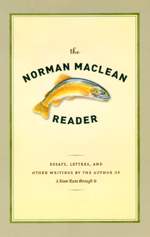Some spots of time in the life of Norman Maclean
 Since its publication in 1976, Norman Maclean’s novella A River Runs Through It has become an American classic, earning him comparison to the likes of Thoreau and Hemingway. Maclean published only three short works of fiction during his lifetime, one of which was A River Runs Through It. None were published until after he retired, at the age of 71, from his career as a professor at the University of Chicago.
Since its publication in 1976, Norman Maclean’s novella A River Runs Through It has become an American classic, earning him comparison to the likes of Thoreau and Hemingway. Maclean published only three short works of fiction during his lifetime, one of which was A River Runs Through It. None were published until after he retired, at the age of 71, from his career as a professor at the University of Chicago.
In a recent article for the Wall Street Journal Joseph Rago asks: “how did this retired professor bring off such accomplished work on his first attempt? And how did he then manage, just as remarkably, to produce a haunting work of nonfiction, the posthumously published Young Men and Fire, Maclean’s exploration of a deadly Montana forest fire in 1949?” Rago continues:
The Norman Maclean Reader points us toward an answer. Smartly edited by O. Alan Weltzien of the University of Montana, the book brings together manuscripts and letters found among Maclean’s papers after his death in 1990, as well as hard-to-find essays, lectures and interviews. Maclean did not draw a distinction between his life and his fiction, and the material in the Reader, much of it available for the first time, burnishes his achievement.
Maclean was deeply influenced by Wordsworth’s notion of “spots of time,” or the moments that give life shape and meaning, “as if an artist had made them,” in Maclean’s words. But he never went in for sentimentality or pointless nostalgia—he was trying, rather, to lend such epiphanies the permanence of literature. …
Read the rest of the article on the Wall Street Journal website. Our website for Norman Maclean, while still in development, has several things by and about Maclean.